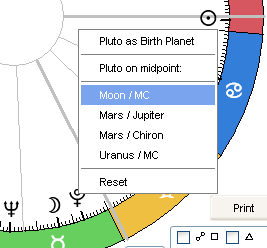
| What Watch? - Tutorial | Next chapter: Transits, Progressions and Solar Arcs | Back to First Page |
Midpoints
Using midpoints is one more way to combine the different planet's energies. It was first established in the 1930s by Reinhold Ebertin and his fellow "cosmobiologists". His book "The Combination of Stellar Influences" still is the reference for this field of astrology. Composite charts, which are based on midpoints, are another popular application.
|
A practical problem with midpoints is the fact that there are so many of them. Finding the interesting and relevant pairs is not easy. Ebertin suggested drawing midpoints in tree form, which is still quite common today. For each planet, midpoints are listed that form an aspect of a multiple of 45°, i.e. a conjunction, an opposition, a square, a semisquare and a sesquiquadrate (1° orb). Midpoints in What Watch |
 |
What Watch supports midpoints in three more ways. First, all midpoint pairs of a selected "birthplanet" are listed on the right panel of the "Data" tab after you press the "Radix" button. Second, the currently selected midpoint is displayed in the chart wheel and aspectarian. Third, you can calculate transit lists for any midpoint.
In practice, I suggest first to look at the midpoints of planets that are important in the chart anyway. If someone has a strong Mars/Neptune relation in the natal chart, the midpoint trees of these two planets should be interesting as well, and the Mars/Neptune midpoint will provide still more insight. Particularly transits on this midpoint tend to be interesting times in the individual's life.
 |
Second, look at midpoints that you feel to be interesting in their own right. You'll not always find something relevant, but there are lots of things to discover that might otherwise stay hidden. One's Own Soul
This is an extreme challenge to the soul, being under permanent pressure by Saturn's inhibitions and fears, its resentment of change, and by Pluto's constant drive to transformation. |
Finally, a closing remark for experienced midpoint users. In the second inset of the above graphic, I've added the 9th harmonic. There's an exact contact between Moon/MC and the Sun, underlining the importance of this midpoint for C.G. Jung. I know that by using the 9th harmonic on a midpoint, I'm not covered by Ebertin any more. He regards midpoints as expression of an axis, not as a single point. In fact, the polarity point of any midpoint is also halfway between the two planets concerned. Ebertin reacted by mostly using the 8th harmonic for analysing midpoints. I'm not convinced of this restriction.
Not only for midpoints: the polarity point is always important for all bodies in the chart, as astrology as a whole is strongly based on thinking in polar opposites that are represented by the axes. So once you decide to use uneven numbered harmonics, that always pose problems when thinking in axes, you can apply these harmonics to midpoints as well.
Literature:
Reinhold Ebertin - The Combination of Stellar Influences, American Federation
of Astrologers:
Tempe AZ 1994
| What Watch? - Tutorial | Next chapter: Transits, Progressions and Solar Arcs | Back to First Page |